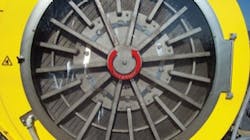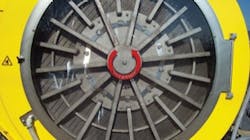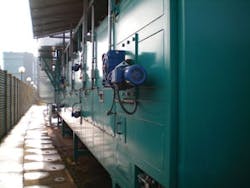When a six-inch water main owned by the City of Rochester, MN, had experienced six breaks since 2002, including two in 2009, officials were tasked with finding a solution. Installed in 1986, the Class 50 ductile iron pipe was highly deteriorated although it had not yet exceeded its life expectancy. Water main leaks had caused interruption of water service for customers and each fix averaged upwards of $3,500 plus property damage. The cause of the deterioration was found to be external corrosion of the cement-lined pipe due to poor soil conditions.
Rather than completely replace the water line, Rochester Public Utilities (RPU), in charge of maintaining the line, chose to rehabilitate two sections of the pipe, 200 feet and 419 feet respectively, with an innovative type of reinforced cured-in-place pipe (CIPP) developed specifically for pressurized force mains and potable water mains.
CIPP was chosen because of the reduced impact it would have on the neighborhood by inserting the liner inside the existing pipe rather than excavating and replacing the entire water main.
The liner, known commercially as the InsituMain™ system, is a fiber-reinforced CIPP product designed for the rehabilitation of pressurized pipelines ranging from 6-inches to 36-inches in diameter.
The fiber-reinforced layers of the InsituMain™ liner form a fully structural cured-in-place pipe for pressurized lines.
Using CIPP enabled RPU to keep one lane of the dead-end street open during the entire project, which would not have been the case if the water main had been replaced by open trench as water mains in southern Minnesota are typically installed with seven feet of cover. In addition, replacement of the existing water main would have necessitated hauling away the poor subgrade soil and hauling in suitable granular backfill. RPU considered this a good pilot project for other water main repair and replacement projects where existing street pavement conditions are relatively good.
Along the rehabilitated sections, five services were successfully reinstated robotically without excavation. The sections were lined with a new fully structural cured-in-place pipe product. The lining eliminated the frequent water main breaks and will provide the city and its residents continuous uninterrupted water service for the expected 50-year life span of the CIPP.
Installation Overview
Prior to installation, temporary water service was established by running a bypass along the street where the pipe was to be rehabilitated. Three insertion pits were dug using a backhoe. Next, the pipes were jet-cleaned using a "porcupine" scrubber. Services were temporarily plugged prior to installation.
The liner was installed using a launcher inversion unit and cured at 180°. After the cure, service connections were cut using a remote control-operated reamer via a TV truck. Finally, the newly lined water main sections were connected back into the system, restoring water service to the neighborhood.
CIPP System
The InsituMain system is reinforced with glass fibers to provide needed strength and stiffness. The added stiffness and strength is tailored to meet the requirements of each particular job by using different weights of the glass fabric or by using multi-layer glass. In addition, overlap joint strength is intentionally designed to make sure it is equal to or greater than the remaining area of the pipe. Both lab and field tests have resulted in improvements to the design, manufacture and installation of the product.
The dry tube material is constructed of both a polyethylene-coated layer and specially constructed glass layer. An overlapped seam is lightly bonded during the manufacturing process to ensure the glass stays in proper alignment prior to installation and expansion. The installation pressure overcomes the seam bonding strength causing the tube to expand to the full size of the host pipe.
The dry tube is impregnated with a specially formulated epoxy resin suitable for drinking water rehabilitation. Both the tube and the resin used for product installation are certified to ANSI/NSF Standard 61 requirements. The special resin system creates an adhesive seal with the inner wall of the host pipe. This seal eliminates any potential leak path between liner and host pipe wall, negating the requirement for end fittings to secure the liner to the host pipe before reconnecting the newly lined section to the rest of the pipeline system.
Prior to its use in the field, the product was tested for burst pressure using sections of the tube made at Insituform's research and development center and at its manufacturing facility in Batesville, MS. The burst test has produced desirable results with a short-term pressure rating of at least 600 psi. An increase in reinforcement loading has led to actual burst tests of up to 1400 psi. The product is designed to perform continually at an operating pressure of 150 psi.
Conclusion
Rochester Public Utilities was satisfied with the project as completed. The project started on-time and was completed within eight continuous working days. The televising phase during the initial water main cleaning activity showed areas in the cement mortar lining that indicated possible locations of additional future water main leaks. However, after several months of use with the lining system, no follow-up water main leaks have been noted. WW
More WaterWorld Current Issue Articles
More WaterWorld Archives Issue Articles





